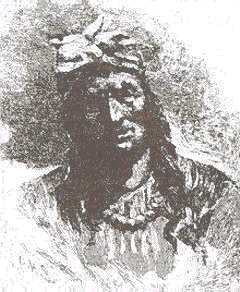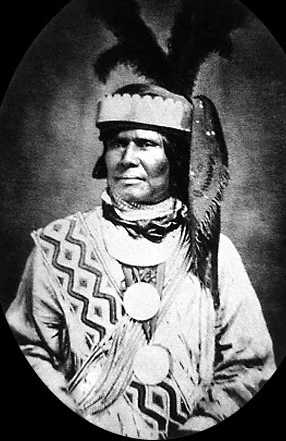Campaigns of 1842
Second Seminole (Florida) War

January 21st
Tiger Tail is apart of an entourage that leaves Fort Brooke in the hopes that they can talk other bands in turning themselves
in for relocation west. During this expedition Tiger Tail escapes and encourages Octiarche and his band of Creeks to resist
to the last man.
January 25th
Major Joseph Plympton and a detachment of 102 men, of the 2d Inf'y, find Halleck Tustenuggee's band
in a hammock near Dunn's Lake. An enlivened skirmish soon ensued which resulted in chasing the band
deeper into the hammock. A plan was devised to converge on and corner Halleck's band of Mikasukis and
Octriarche band of Creeks in between the following columns:
Colonel John Garland, 4th Inf'y, operating from Fort Fanning
Col Gustavus Loomis, 6th Inf'y, operating in the Wacasassa Hammock
Lt. Col. William Whistler, 7th Inf'y, operating in the area between Micanopy and Wacahoota
February
Col. Worth states that he believes that the southern portion of the state is almost rid of any presence of hostile bands
and orders all but two companies of his troops stationed in that area to move north. The Third Artillery is relieved of
its duties in Florida and starts to leave.
February 5th
Col. Worth sends a message stating that since his taking over command in Florida he has shipped 230
Seminoles west, 68 of them being warriors. He also suggests that the remaining bands were so small that
it was not worth the time and effort to round them up. He proposes that a reservation be set up on the west coast
of Florida south of Pease Creek, where the remaining bands can plant and harvest crops in peace. This plan
would be rejected, but not forgotten, by the Federal Government.
March
Col. Worth's plan of white resettlement in the territory sees 164 men, 137 women, and 192 children along with
103 slaves and 56 slave children moving back or starting settlements.
April 19th
Halleck Tustenuggee and his band of 40 warriors are cornered in a hammock near the settlement of Peliklakaha. Col.
Worth sends a force of 400 men, being made up of the 2d, 4th, and 8th Inf'y Reg'ts, to subdue the unruly band.
When his force arrived at the hammock they found the band had prepared a defensive position much like the one
they had at the battle of Lake Okeechobee. In what would be considered the last battle of the Second Seminole War
the force of regulars fired into the hammock and charged the Indians postion. The band scattered and most
avoided capture. The U. S. force only found the supplies left behind and the bands baggage.
April 29th
Halleck accompanied by his two wives and children arrive at Warm Springs in order to parley with Col. Worth. The two leave
Warm Springs and travel to Fort King to join in on a big feast promised by the commander of Fort King. The army was hoping that
the lure of great quantities of food and whiskey would bring in the surrounding bands so they may be captured. When Col. Worth and Halleck
Tustenuggee arrived at the fort they found that there was a total of 43 warriors, 37 women and 34 children present for the feast.
Upon entering the fort a signal was sounded and the whole party was surrounded and taken into custody.
May 10th
In Washington the presidents entire cabinet resigns over political differences and a new Secretary of War is appointed. John C.
Spencer takes over the position and sends a message to Col. Worth that he should persue an end to hostilities as soon as
it is possible.
July 14th
Halleck and his people are transported out of the territory for the west.

August 5th
Col. Worth sends word that he is at Cedar Key and is willing to parley with any chiefs remaining to find a solution to the hostilities.
Holato Mico and two of his sub-chiefs arrive at Cedar Key to talk with Col. Worth.
August 9th
Tiger Tail and Octiarche arrive at Cedar Key to talk with Col. Worth.
August
At the talks held in Cedar Key, Col. Worth promises the chiefs assembled that they can plant their crops and live peacefully
on a designated reservation south of Pease Creek along the west coast of Florida.
August
The government passes the Armed Occupation Bill into law. Under this new law people would be given land grants in the territory of Florida
if the following stipulations were followed:
The land occupied must be south of a east-west line running 3 miles north of Palatka and 10 miles south of Newnansville.
It must be occupied for a period of five years.
You must build a house and clear five acres for agriculture.
The land occupied can not be within 2 miles of a military post.
In this a predecessor of homesteading the government gave away nearly 210,000 acres to grant claimants in the 2 years the law
was in effect. This would hopefully give a good buffer zone of armed men on the edge of white settlements in Florida.
August 3d
Lt. McLaughlin commander of the naval detachment operating in the Everglades is ordered to dissolve and return to fleet duties.
August 14th
Col. Worth proclaims that the war in Florida is over.
October 12th
The only regulars left in the territory by this time was composed of men from the 3d Inf'y Reg't, 8th Inf'y Reg't, and six companies of the
4th Inf'y Reg't. These men were scattered throughout the territory, stationed at various posts.
This war never ended completely it just decreased to a low roar. The remaining bands in the territory were very small and hardly worth
the time and effort of the army to actively pursue them. Even though depredations still happened in the territory the army command
associated this to the children who grew up only knowing war and expected to capture them eventually. In the course of the
war against the tribes in Florida a total of 3,824 people were relocated to the west. The cost to the army was 1,466 killed, 328 of that
number were killed in combat, this would come out to be roughly 14 percent of the total amount of the regular army that served in the
theatre throughout the over six years that the war took place. In addition to the regular army that served in the war over 30,000
citizen soldiers served of which only 55 were killed in action. The government spent $30 million to $40 million in the campaigns to
subdue the hostile bands and was only successful in cornering most of them onto a reservation and leaving a band led by Billy Bowlegs
to dwell unmolested deep in the Everglades. This would be an 19th century version of the Vietnam War that would go down in history
as the most expensive Indian campaign the U. S. would ever endeavor in and the only one that never ended in a complete suppression
of the Indians engaged.


